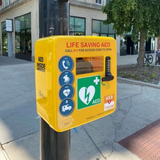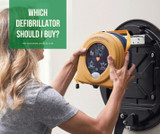When should a defibrillator be used and when not?
When used at the appropriate time, a defibrillator can save a life. Working by delivering a shock to the heart in order to help it restore its natural rhythm, defibrillators are true lifesavers for those who are suffering a sudden cardiac arrest. The chances of survival are as high as 90% if a defibrillator if used within the first minute of someone falling ill, making it an invaluable medical device.
Defibrillators are cleverly designed by specialists who have developed them to only deliver a shock should one be needed. Scanning the heart, a defibrillator determines whether a shock is needed and will never deliver a shock if one is not. If you have an automatic defibrillator, it will deliver a shock itself and if not, it would simply require you to push a button in order for the shock to be administered.
There are however, certain scenarios when you should not use a defibrillator with one example being if the victim is laying in water, has water on them or their chest is very wet from sweat or rain.
Water can interfere with the stickiness of the electrode pads that are applied to the chest as well as water of course conducting electricity. In order to safely use a defibrillator, you should remove the person from water, check there are not any puddles around you, the victim or defibrillator and remove both wet and dry clothing from their chest.
A defibrillator should also not be used if the victim has a medication patch or a pacemaker. This is because the implanted device may sustain damage if the electrode pads are placed too closely or directly over the device. It’s important to place them as acceptable to the correct positioning as possible without being too close to the pacemaker.
You also shouldn’t use adult electrode pads on children who are under eight years old unless you have no access to paediatric pads. This is because defibrillators that are suitable for children deliver a lower shock as children naturally need less electricity than adults to help their heart restore to its natural rhythm. Using an adult defibrillator on children under eight years old is better than not using a defibrillator but, should still be considered a last resort.
When considering infants who are under 12 months old, you should never use a defibrillator as delivering even a shock from a children’s defibrillator would be too high. You should call an ambulance as you would for any cardiac arrest victim and begin CPR straight away.
Although defibrillators are life saving devices, it’s really important to consider the rare circumstances where they cannot be used. Quickly reacting to a situation can make the difference between life and death so, if someone has fallen ill and is wet make sure you take them out of water and place them somewhere dry. Also, always try and use the appropriate electrodes – for children under eight there are more suitable pads which are effective.
Overall, defibrillators are great medical devices that will save lives should a cardiac arrest occur but, it’s just important to ensure you are using it at the right time to ensure maximum safety.
Recent Posts
-
Empowering Communities: The Lifesaving Impact of CPR on Restart a Heart Day
Every year, on and around October 16th, an important event takes place - Restart a Heart Day. This a …16th Oct 2023 -
Which home defibrillator?
80% of all out of hospital cardiac arrests occur at home. Defibrillators are often available in loca …4th Dec 2022 -
Which defibrillator should I buy?
There are many defibrillators available on the market and it can become overwhelming knowing which o …4th Nov 2022




